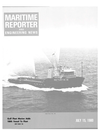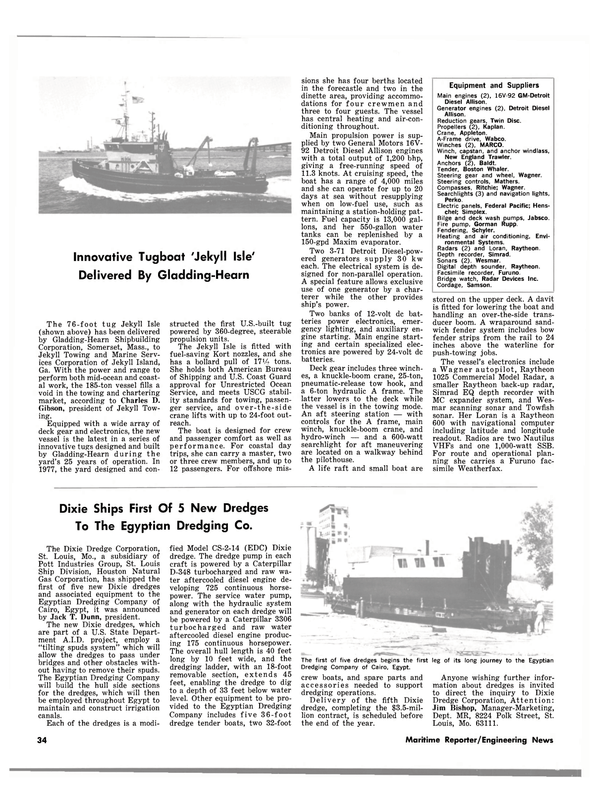
Innovative Tugboat #Jekyll Isle7 Delivered By Gladding-Hearn
The 7 6 - f o o t tug Jekyll Isle (shown above) has been delivered by Gladding-Hearn Shipbuilding Corporation, Somerset, Mass., to Jekyll Towing and Marine Services Corporation of Jekyll Island, Ga. With the power and range to perform both mid-ocean and coastal work, the 185-ton vessel fills a void in the towing and chartering market, according to Charles D.
Gibson, president of Jekyll Towing.
Equipped with a wide array of deck gear and electronics, the new vessel is the latest in a series of innovative tugs designed and built by Gladding-Hearn during the yard's 25 years of operation. In 1977, the yard designed and constructed the first U.S.-built tug powered by 360-degree, steerable propulsion units.
The Jekyll Isle is fitted with fuel-saving Kort nozzles, and she has a bollard pull of 171 A tons.
She holds both American Bureau of Shipping and U.S. Coast Guard approval for Unrestricted Ocean Service, and meets USCG stability standards for towing, passenger service, and o v e r - t h e - s i de crane lifts with up to 24-foot outreach.
The boat is designed for crew and passenger comfort as well as performance. For coastal day trips, she can carry a master, two or three crew members, and up to 12 passengers. For offshore missions she has four berths located in the forecastle and two in the dinette area, providing accommodations for f o u r crewmen and three to four guests. The vessel has central heating and air-conditioning throughout.
Main propulsion power is supplied by two General Motors 16V- 92 Detroit Diesel Allison engines with a total output of 1,200 bhp, giving a free-running speed of 11.3 knots. At cruising speed, the boat has a range of 4,000 miles and she can operate for up to 20 days at sea without resupplying when on low-fuel use, such as maintaining a station-holding pattern.
Fuel capacity is 13,000 gallons, and her 550-gallon water tanks can be replenished by a 150-gpd Maxim evaporator.
Two 3-71 Detroit Diesel-powered generators supply 30 kw each. The electrical system is designed for non-parallel operation.
A special feature allows exclusive use of one generator by a charterer while the other provides ship's power.
Two banks of 12-volt dc batteries power electronics, emergency lighting, and auxiliary engine starting. Main engine starting and certain specialized electronics are powered by 24-volt dc batteries.
Deck gear includes three winches, a knuckle-boom crane, 25-ton, pneumatic-release tow hook, and a 6-ton hydraulic A frame. The latter lowers to the deck while the vessel is in the towing mode.
An aft steering station — with controls for the A frame, main winch, knuckle-boom crane, and hydro-winch — and a 600-watt searchlight for aft maneuvering are located on a walkway behind the pilothouse.
A life raft and small boat are stored on the upper deck. A davit is fitted for lowering the boat and handling an over-the-side transducer boom. A wraparound sandwich fender system includes bow fender strips from the rail to 24 inches above the waterline for push-towing jobs.
The vessel's electronics include a Wagner a u t o p i l o t , Raytheon 1025 Commercial Model Radar, a smaller Raytheon back-up radar, Simrad EQ depth recorder with MC expander system, and Wesmar scanning sonar and Towfish sonar. Her Loran is a Raytheon 600 with navigational computer including latitude and longitude readout. Radios are two Nautilus VHFs and one 1,000-watt SSB.
For route and operational planning she carries a Furuno facsimile Weatherfax.
Read Innovative Tugboat #Jekyll Isle7 Delivered By Gladding-Hearn in Pdf, Flash or Html5 edition of July 15, 1980 Maritime Reporter
Other stories from July 15, 1980 issue
Content
- Hitachi Receives First U.S. Order For Two Jackup Drilling Rigs page: 7
- Mangone Delivers Advanced Offshore Research Vessel page: 8
- Fireboat Gulf Fleet No. 40— 100th Vessel Joins A Growing Fleet page: 10
- O&K Will Build Hopper Dredge For Indonesia page: 10
- New Primary Battery Introduced By SAFT —Literature Available page: 12
- Two New Contracts For Drill Barge And Jackup Won By Promet Private page: 12
- W.L. Rose Jr. Named President Of Williams-McWilliams page: 15
- Samson Offers New Shear Pin Shackle- Literature Available page: 15
- Canada's Arctic Pilot Project page: 16
- Two Naval Architects Join Waller & Assoc. page: 18
- Bill Cleary Honored By AWO Board, Moynihan page: 18
- Brochure Available On Norshipco's Three Expanded Shipyards page: 22
- Cliff Drown Named New President Of State Boat page: 22
- Steam Engine Literature Available From Skinner page: 22
- Butterworth Introduces Marine Liqua-Blaster —Literature Available page: 24
- Firm Changes Name To Houston Marine Services page: 24
- Jurgen Manske Named Representative For Hapag-Lloyd Service page: 24
- Leggett, Lowen And Singman Named To NMC Board Of Governors page: 25
- French And Campbell Named To Head NMC Shipyard Council page: 27
- Lockheed Places $8.6-Million Order For Colt/Pielstick Diesel Engines page: 28
- McDermott Scotland Gets $92-Million Contract From Marathon Oil U.K. page: 30
- Maintenance Guide For Shipboard Officers Offered By Chesterton page: 30
- 100,000-dwt Floating Dry Dock Increases HUD's Tsing Yi Capacity page: 33
- Literature Available On Foxboro's New On-Line Ferrograph page: 33
- Innovative Tugboat #Jekyll Isle7 Delivered By Gladding-Hearn page: 34
- Dixie Ships First Of 5 New Dredges To The Egyptian Dredging Co. page: 34
- Fuel Conservation Subject Of N.Y. SNAME Symposium Sept. 22-23 page: 35
- New Crew/Supply Vessel 'Audrey' Powered By Four MTU Diesels page: 40
- Caicos Petroleum Services Establishes Transfer Facility page: 41
- Title XI Approval For Three Product Carriers To Cost $197 Million page: 42
- Title XI Sought For 20 Barges And 3 Towboats page: 42
- Ingram Exploration Names Thomas M. Ellis Jr. VP Of Exploration page: 43
- Atlantic Marine To Build Two NSF Research Ships At Cost Of $5.9 Million page: 43
- Pielstick Diesels To Power French Navy And Yugoslavian Vessels page: 44
- Swanson Promoted To VP & General Manager Of Dillingham Shipyard page: 45
- Orders For Six Ships To Cost $180 Million Placed By Cast Group page: 45
- Proposed Shipboard Maneuvering Data page: 46
- J.R. Mills Appointed At New Allis-Chalmers Marine Diesel Division page: 48
- Sartor And Jones Promoted To New Posts At Farrell Lines page: 49
- Electro-Nav Acquires Marine Division Of British Electronics Firm page: 49
- SNAME Chesapeake Section Hears Update Report On Design Of Multipurpose Mobilization Ship page: 50
- AFO Shipyards Appoints Representative For U.S. And Canada page: 51
- NASSCO Lays Keel For Second Union Oil Product Carrier page: 52
- Levingston To Build $37-Million Jackup Rig For Noble Drilling Corp. page: 54
- O&K Shipyard Delivers Offshore Crane Platform Designed By RSV Gusto page: 54
- Submersible Deck Cargo Barge Delivered To Nedbarges Sublift page: 58
- Mangone Launches Special Purpose Tanker For Sun Transport page: 58
- Offshore Construction For $50-Million Pipeline Goes To J. Ray McDermott page: 59


